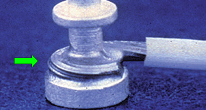- Sat Mar 06, 2010 12:58 am
#95498
So I was going through some of NASA's Workmanship reference documents (what can I say, it's friday night, and I decided to get a little crazy)
And I ran into this. Turret Terminals:

I know I've seen them back in the day. But, when I need aboard to wire connection, and I don't want to spring for a "Terminal Block"

I just design the PCB with a large enough hole for the wire and solder the wire as if it was a through hole and secure it to the board with a zip tie with an even larger hole.

Anything wrong with doing that? And what the heck were these turret terminal for? Seems to me you are just making lever to rip things apart.
Thanks!
And I ran into this. Turret Terminals:

I know I've seen them back in the day. But, when I need aboard to wire connection, and I don't want to spring for a "Terminal Block"

I just design the PCB with a large enough hole for the wire and solder the wire as if it was a through hole and secure it to the board with a zip tie with an even larger hole.
Anything wrong with doing that? And what the heck were these turret terminal for? Seems to me you are just making lever to rip things apart.
Thanks!
